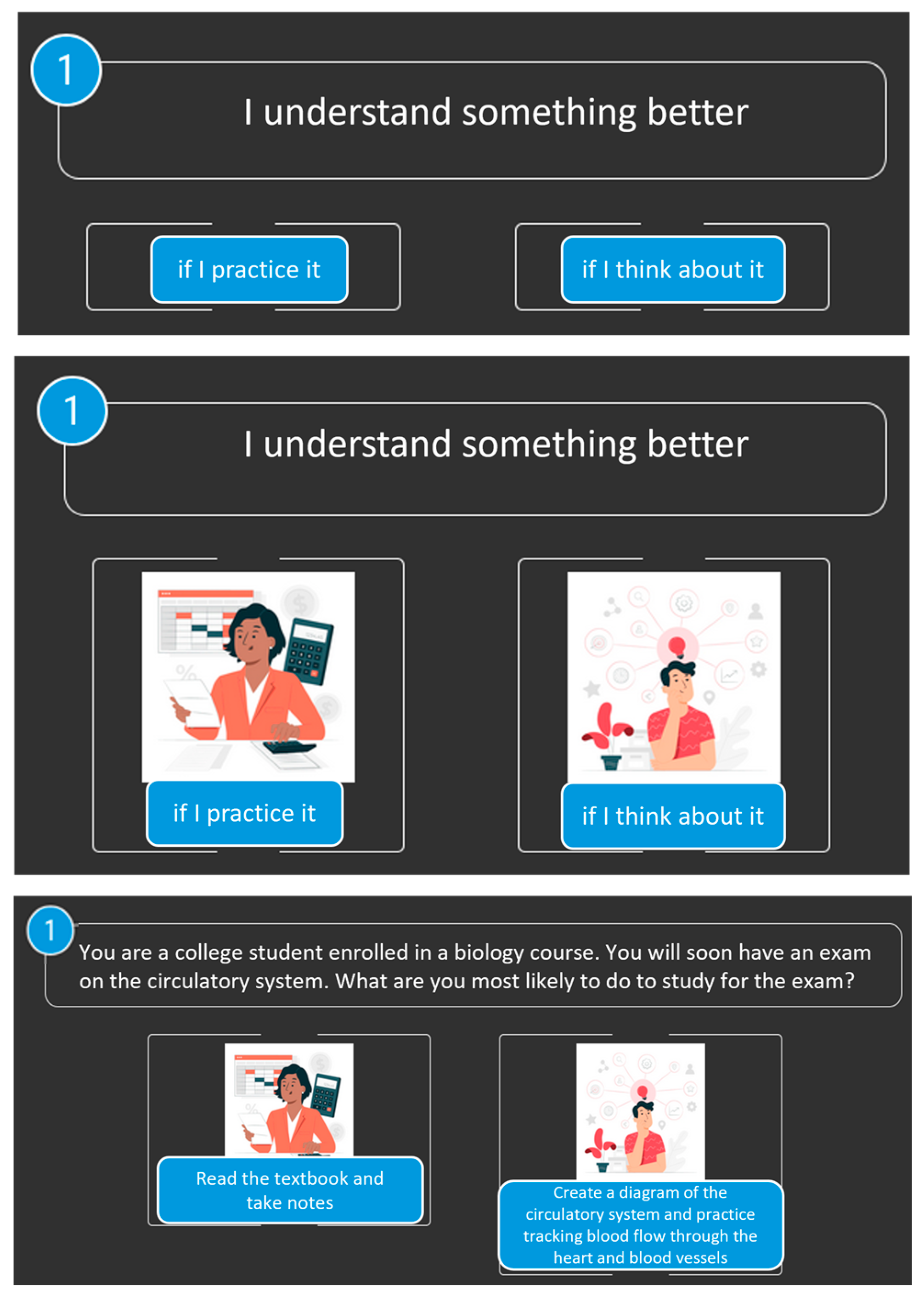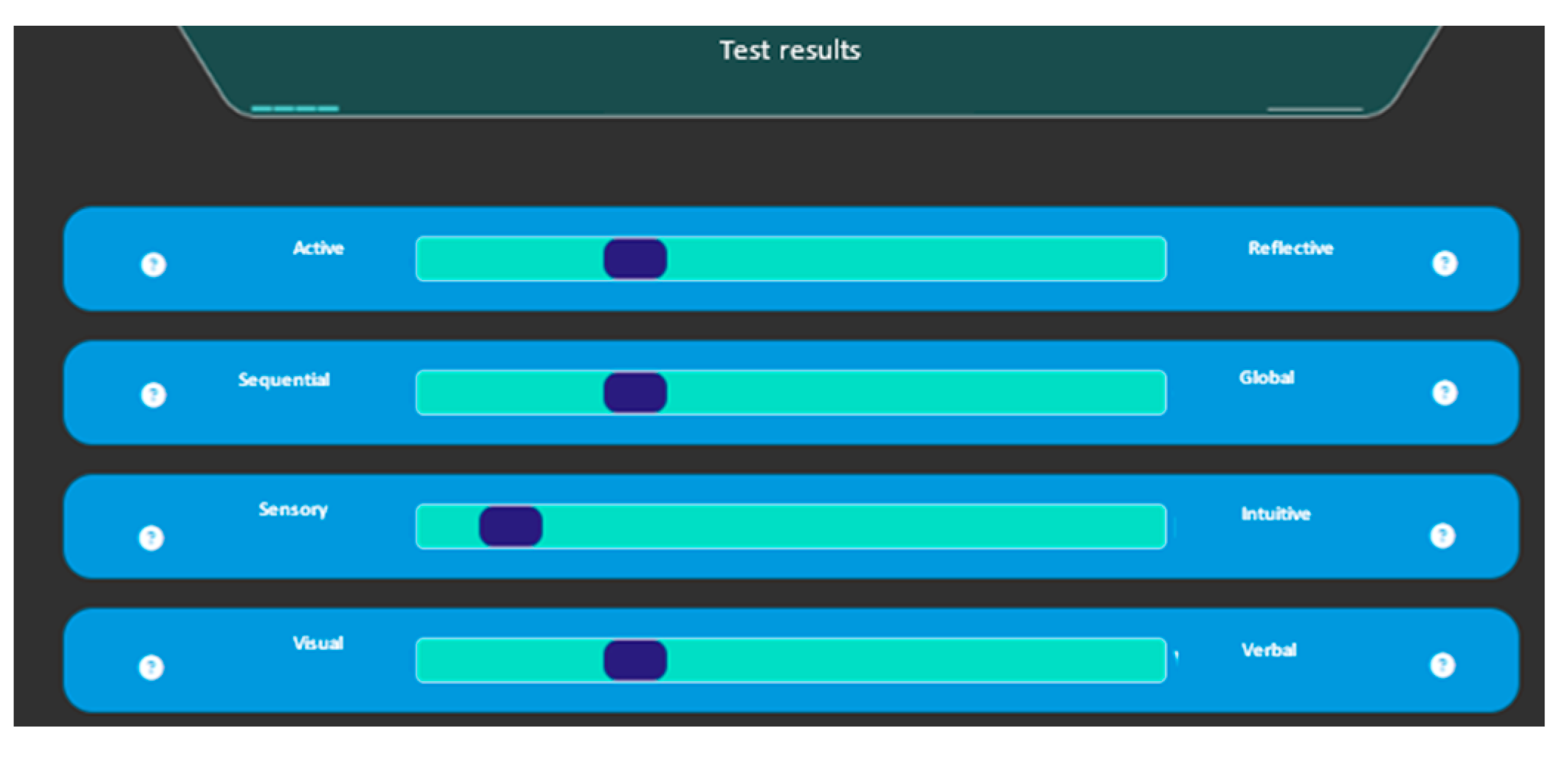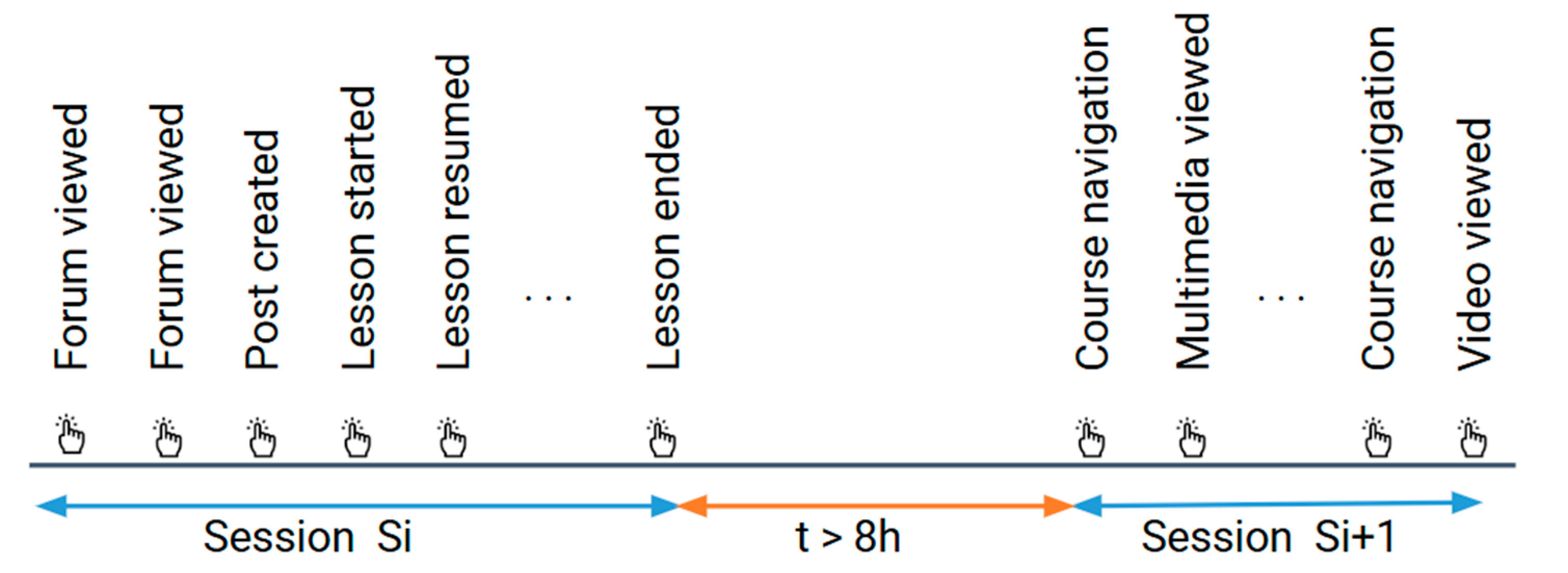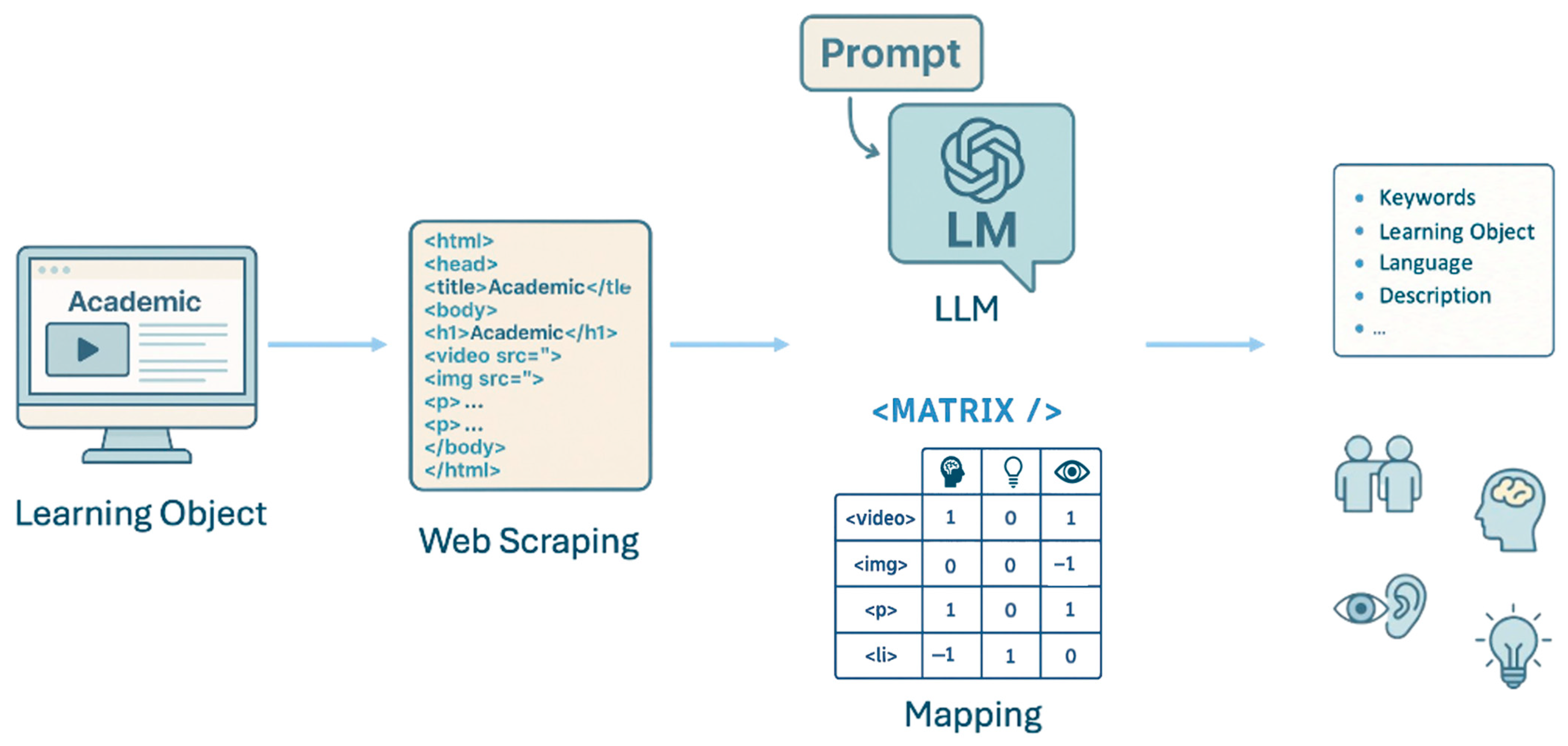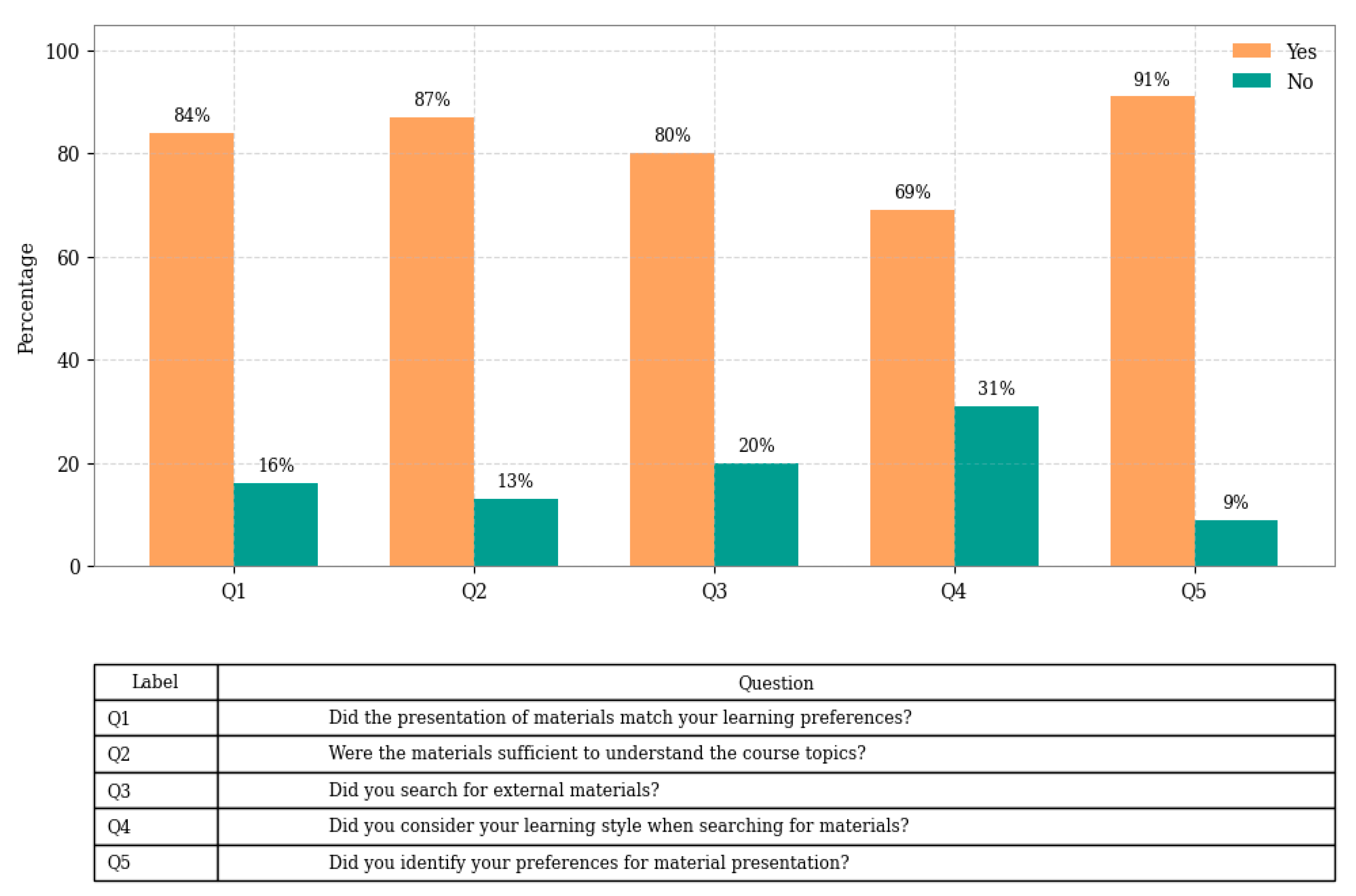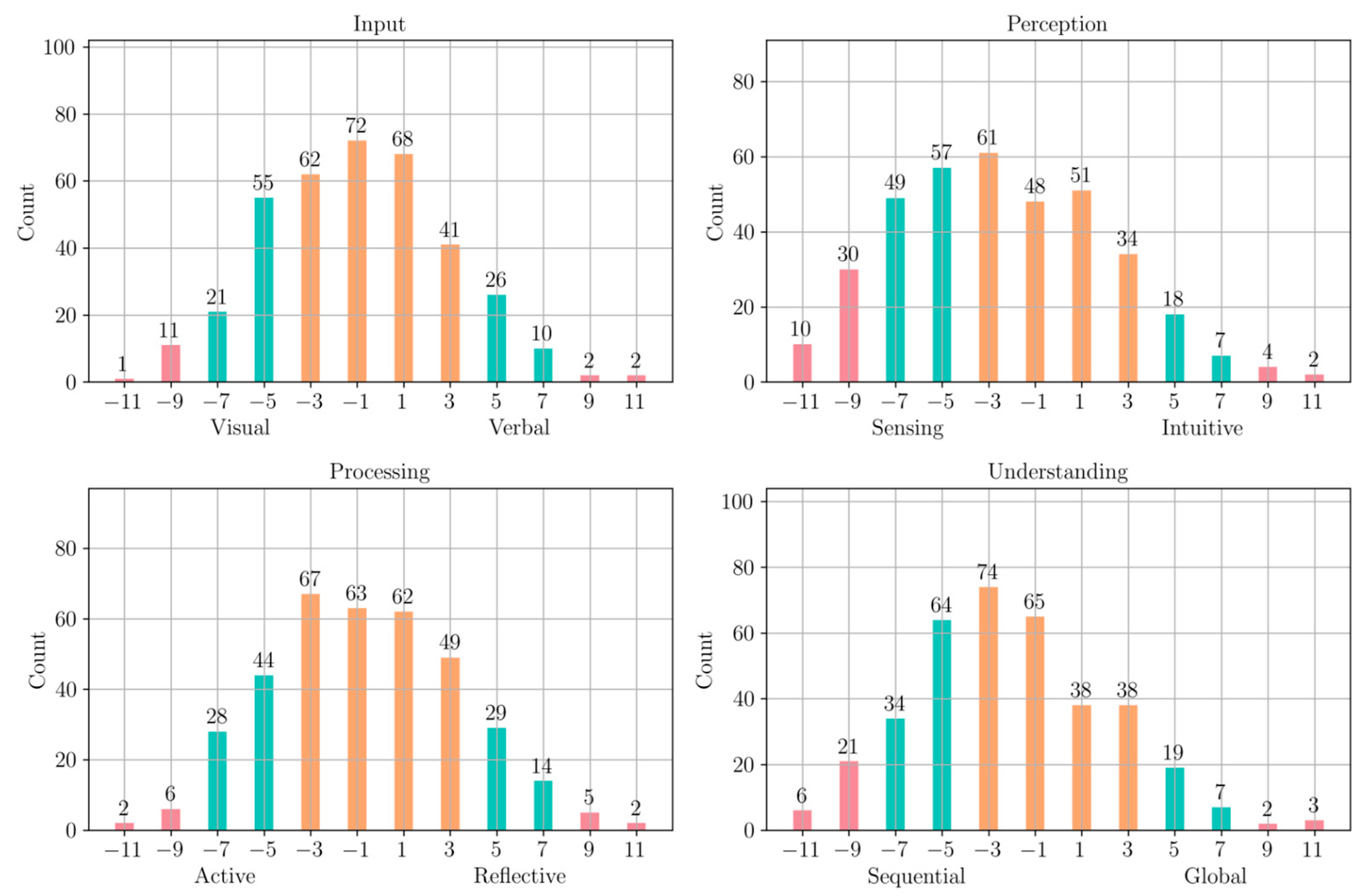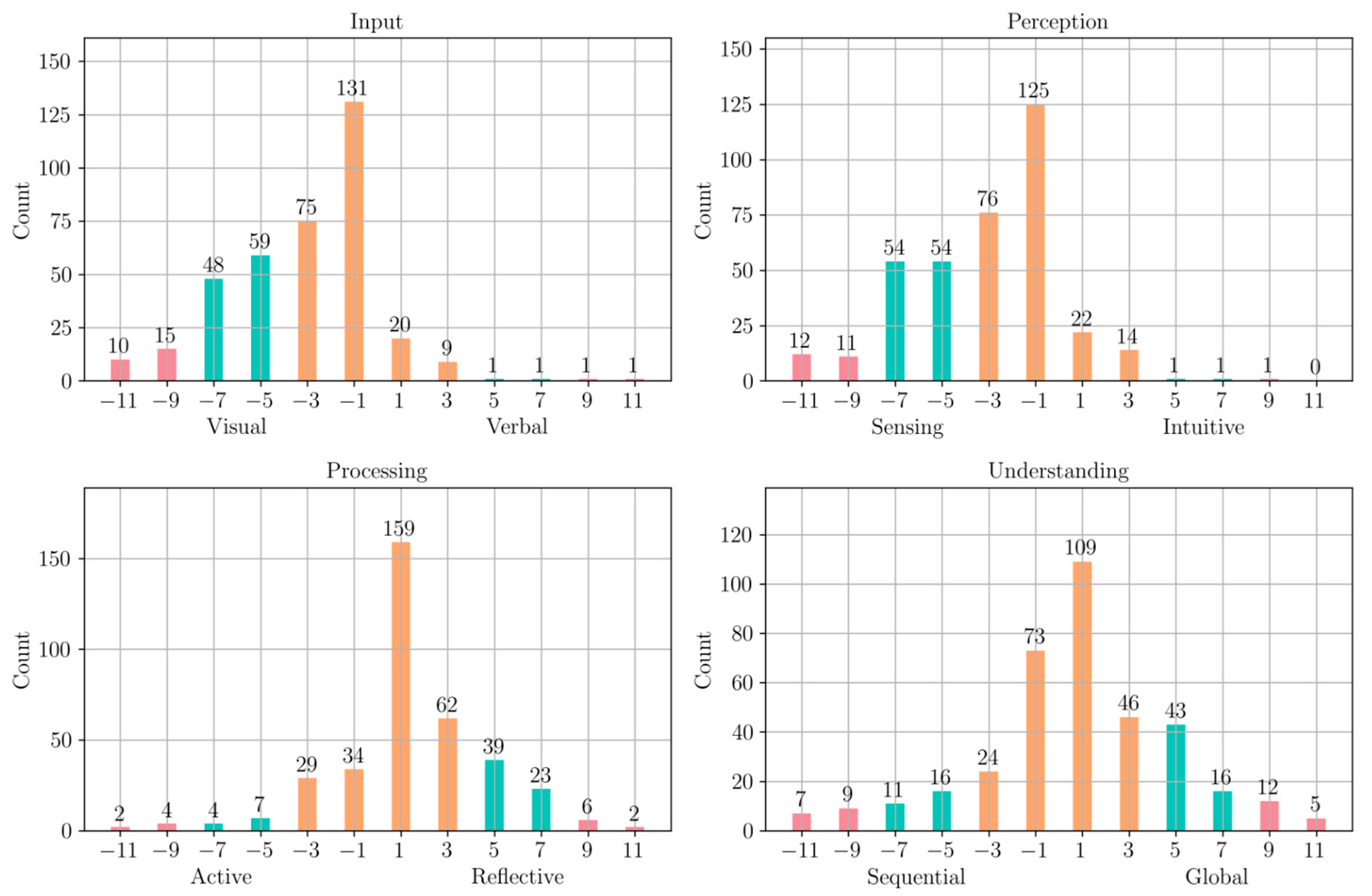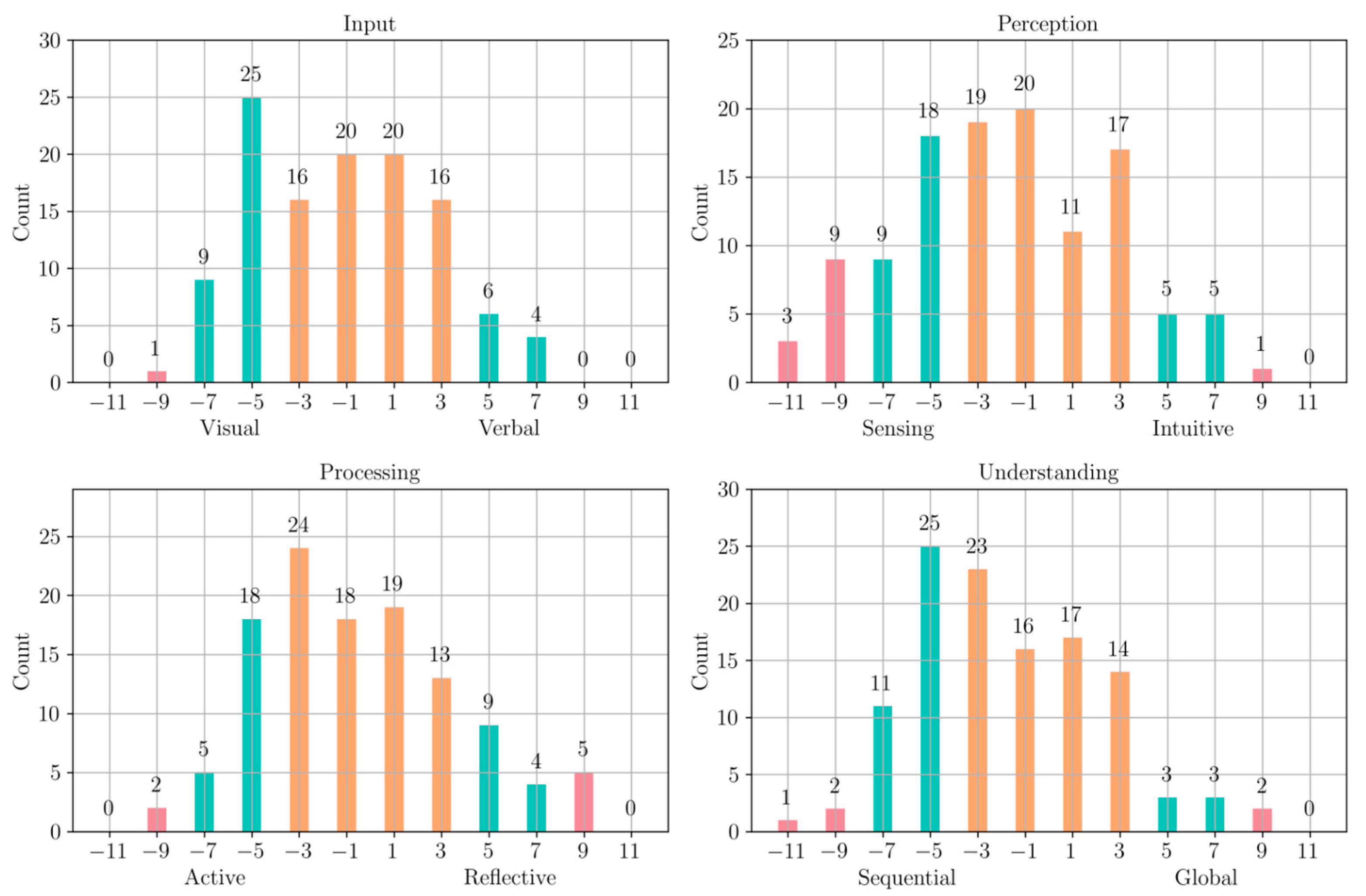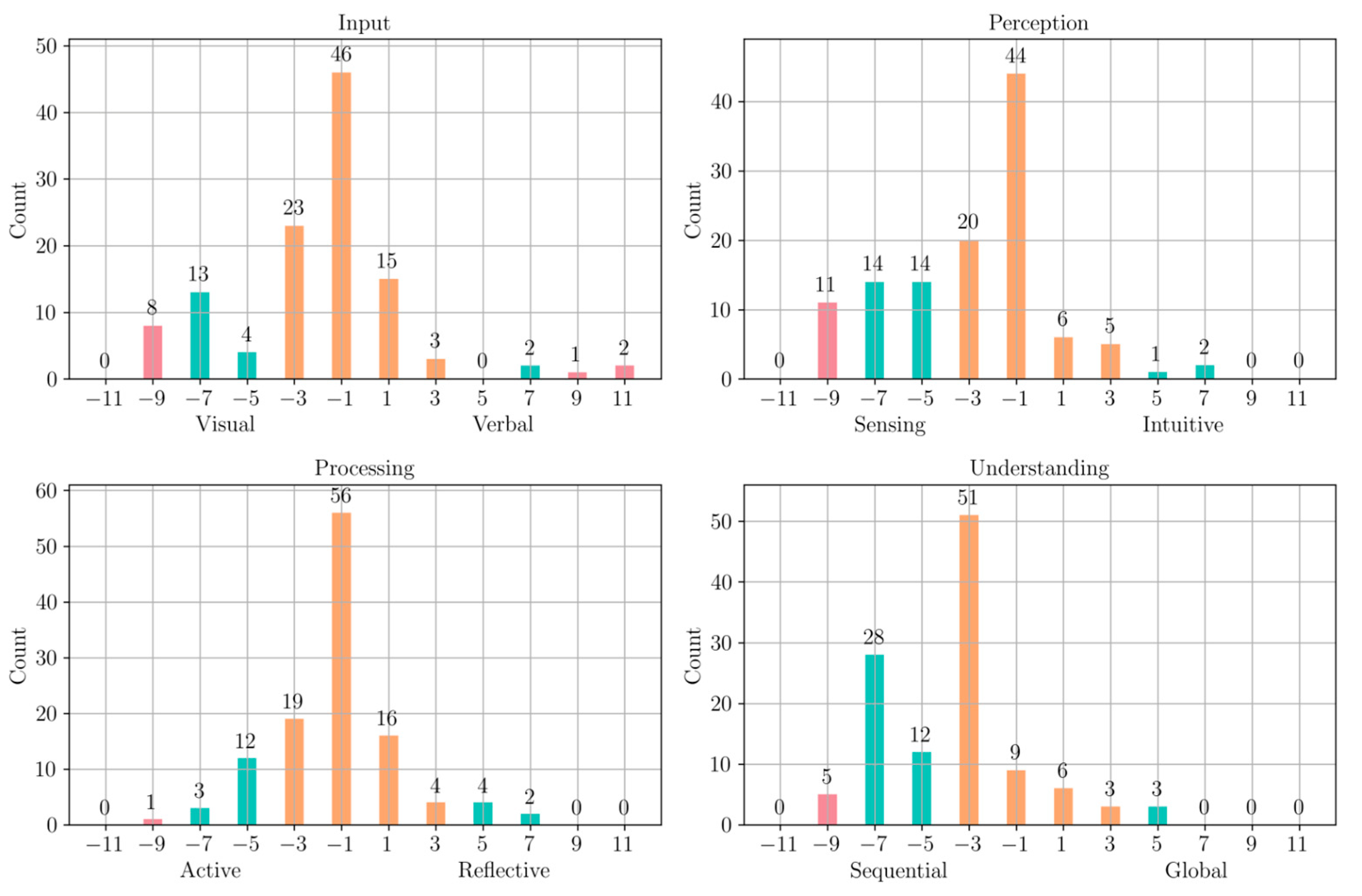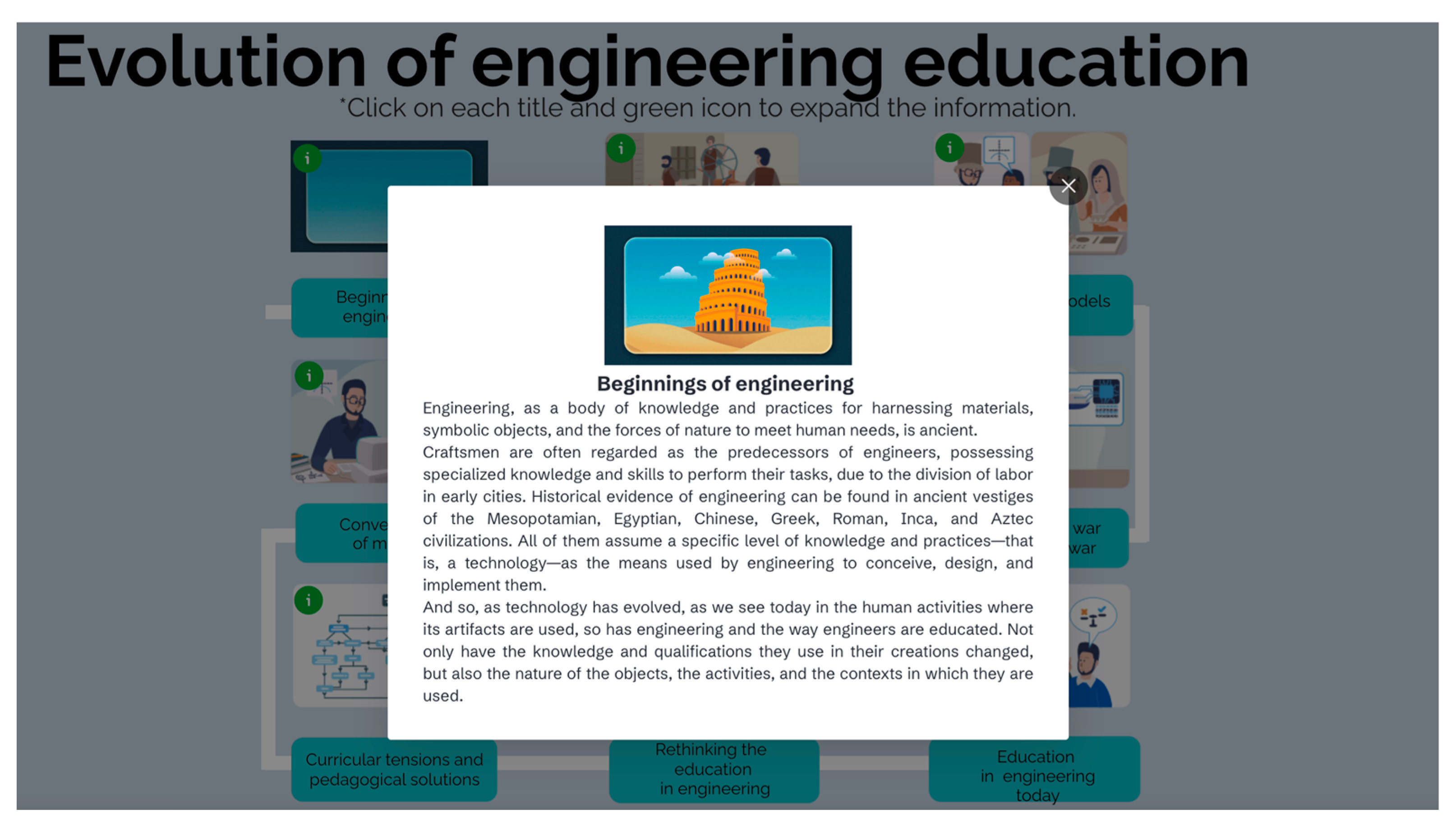1. Introduction
The digitalization of education has greatly broadened access to learning beyond the confines of conventional classroom environments. While virtual education, enabled by digital platforms, provides increased flexibility, it also presents persistent challenges, including limited student engagement, a lack of tailored learning experiences, and insufficiently effective assessment strategies. AI offers promising solutions to these issues by enabling intelligent automation, fostering adaptive and personalized learning, and promoting more interactive educational experiences [
1].
Conventional virtual learning environments often fail to accommodate diverse learning preferences and do not sufficiently address regional variations in educational needs. A large number of e-learning platforms are built upon rigid instructional frameworks that often prove inadequate for students coming from varied educational contexts. The integration of AI-driven adaptive learning systems allows educational institutions to customize content in real time, aligning it with the unique needs of each student. This type of personalization is especially crucial in marginalized or remote areas, where uniform teaching strategies may fall short due to cultural nuances and infrastructural limitations [
2].
Maintaining student engagement remains a major challenge in virtual learning settings. Many students experience difficulties with motivation and self-regulation in online environments, which often leads to elevated dropout rates. AI-based solutions—such as real-time feedback mechanisms, intelligent chatbots, and interactive learning dashboards—offer promising strategies to boost engagement by providing tailored recommendations and instant support. These technologies contribute to a more immersive and responsive learning experience, enabling students to engage with educational content in ways that reflect their individual preferences and learning styles [
3].
AI also offers significant potential to transform educational management and assessment practices. By incorporating predictive analytics into virtual learning platforms, institutions can proactively identify students at risk of underperformance, adjust the complexity of course materials in real time, and refine instructional approaches to better support diverse learning needs [
4]. Through the application of machine learning algorithms to student performance data, AI can create individualized learning trajectories, allowing each learner to advance at a pace that best suits their abilities and progress.
In this context, AI serves as a driving force for innovation in education by reshaping conventional instructional models into personalized, adaptive, and data-informed learning experiences. AI-based systems continuously analyze student performance, learning preferences, and engagement patterns to deliver timely feedback and individualized recommendations [
5]. Additionally, AI technologies have the potential to enhance various components of digital education, including automated assessment tools, intelligent tutoring systems, and predictive analytics. These tools can support educators in identifying specific learning needs and tailoring interventions accordingly. However, the extent to which these systems improve educational outcomes depends on multiple factors such as the quality of the data, instructional design, and the context of implementation. Recent studies have explored these benefits and suggested promising applications, while also highlighting the need for further validation and critical reflection on pedagogical effectiveness [
6].
This paper outlines the methodological framework and initial findings of the project titled “Didactic Innovation Strategy with an Adaptive Approach Supported by Artificial Intelligence Techniques”. Supported by Colombia’s General Royalties System, the project sought to enhance the department of Antioquia’s capabilities in the areas of Science, Technology, and Innovation (STI). Its central objective was to advance research efforts aimed at designing adaptive didactic strategies powered by AI technologies.
The project had two primary objectives: (1) to evaluate the pedagogical implications of personalized learning by analyzing how students’ interactions aligned with their identified learning styles, and (2) to develop and implement an AI-based framework to support this personalization in virtual environments. The integration of the AI-based framework with pedagogical analysis within a single study was intentional, as the effectiveness of the personalization model depends on both its technological performance and its impact on student learning behavior.
The structure of the paper is as follows:
Section 2 introduces the conceptual framework;
Section 3 details the methodological approach employed;
Section 4 presents the key findings; and
Section 5 offers the study’s conclusions.
4. Results
4.1. Data
The results presented in this section were obtained in a case study conducted during the first academic semester of 2025 in the Logical and Mathematical Reasoning PPVU course. The course spanned eight weeks and was designed for an estimated total workload of 48 h, with a recommended study time of six hours per week. It was structured into five thematic units, each containing a combination of educational resources and assessment activities.
A total of 12,212 undergraduate students were enrolled in the same virtual classroom within the institutional LMS. Participants were randomly assigned to four groups of approximately equal size, comprising one control group and three experimental groups. The distribution of participants is presented in
Table 4.
All groups had access to the same base course structure, including instructional materials, activities, and assessments. However, in the experimental groups, the content corresponding to specific topics was replaced by SCORM packages with differentiated presentation formats according to group assignment:
Adaptive SCORM Group: Each student was shown only the version of the learning object that corresponded to their learning style, as identified through the Felder-Silverman Learning Styles Questionnaire (FSLSQ). The system displayed a single version per topic, aligned with the learning preferences indicated in the questionnaire.
Balanced SCORM Group: All versions of the learning objects were made available simultaneously to each student. No personalization was applied based on learning style, and the student could freely select their preferred version.
AI-Suggested SCORM Group: In this group, the system initially selected the version of the learning object corresponding to the student’s FSLSQ-identified learning style. Subsequently, the system re-evaluated interaction data at fixed intervals and updated the learning style classification based on behavioral indicators. Recommendations were adjusted accordingly over the duration of the course.
From an ethical standpoint, all students enrolled in the course were informed about the study and asked to provide their voluntary consent to participate. Upon accessing the course for the first time, students were presented with a message explaining the objectives of the research, followed by a consent question regarding their willingness to participate. This procedure ensured that students’ autonomy and decision to participate were fully respected. Only the data of students who explicitly agreed to participate were included in the analysis. Furthermore, all data were anonymized to ensure the protection of participants’ personal information and to comply with institutional and ethical research standards.
4.2. Survey Results on Learning Styles
A total of 2616 out of 12,212 enrolled students completed the FSLSQ, distributed across the four experimental groups as follows: Control (n = 610), Adaptive SCORM (n = 661), Balanced SCORM (n = 656), and AI-Suggested SCORM (n = 689). The responses revealed consistent tendencies in learning style preferences across all dimensions of the FSLSM.
Perception Dimension: A dominant preference for the Sensing style was evident in all groups, ranging from 70.5% to 71.7%. This suggested a general inclination among students toward concrete information, practical examples, and real-world applications in their learning.
Input Dimension: Most students preferred Visual information formats, with percentages between 58.4% and 62.7%. This reinforced the importance of integrating visual resources such as diagrams, videos, and charts to support comprehension.
Processing Dimension: The Active style was more prevalent than the Reflective style across all groups (58.7–62.5%), indicating that many students favor learning by doing, through collaboration, experimentation, and interaction.
Understanding Dimension: The Sequential learning preference prevailed in all groups, with the Balanced SCORM group showing the highest proportion (68.2%). This points to a preference for logically ordered, step-by-step instruction.
These results collectively underscored the pedagogical relevance of adapting learning experiences to accommodate dominant learning preferences, particularly those favoring sensory-rich, visually supported, and actively engaged content delivered in a logical sequence.
The analysis of student interaction with SCORM-based learning objects across all four experimental groups revealed variations in usage patterns, completion rates, and content preferences.
Table 5 presents the number and percentage of users who accessed each SCORM-based learning object across the four groups in the case study: Adaptive SCORM, Balanced SCORM, AI-Suggested SCORM, and the Control group. The data revealed differences in content engagement patterns by topic and group, allowing comparisons between personalized and non-personalized resource delivery approaches.
Notably, while all groups had access to the same course content, the way it was presented—particularly in the AI-Suggested group, which dynamically adapted based on interaction data—appeared to influence engagement. This group maintained comparable levels of resource use and completion with the Adaptive and Balanced groups, although topic-specific differences emerged.
These observations suggested that adaptive personalization, particularly when updated dynamically through AI, holds potential for enhancing content relevance and improving user interaction. Furthermore, the consistency in engagement across groups reinforces the value of differentiated content delivery, aligned with student preferences, to support deeper learning and more effective use of instructional resources.
In addition, after completing the course, the student was invited to evaluate how much studying the materials helped them in their development on the course topics according to their learning preferences. The survey aimed to explore students’ perceptions regarding the alignment between course materials and their learning preferences, as well as their study behaviors and awareness of learning styles.
Figure 6 presents the results of a survey, the grouped bar chart summarizes responses to five key questions: perceived alignment of materials with learning styles, sufficiency of resources, use of external materials, consideration of learning styles in resource selection, and identification of personal presentation preferences. The results offered insight into the relevance of adaptive content and the metacognitive engagement of learners in virtual learning environments.
The survey administered revealed predominantly positive perceptions from students regarding the adaptation of course materials to their individual learning preferences. Specifically, 84% of respondents indicated that the way materials were presented aligned with their preferred learning styles. This suggests a strong level of perceived relevance and adequacy in the instructional design among participants in the experimental groups.
In addition, 87% of students considered the materials available on the platform sufficient to support their understanding of course content. Interestingly, 80% reported seeking external materials to further deepen their learning. This behavior did not contradict the perception of sufficiency but rather indicated proactive engagement and a desire to enrich understanding beyond the provided content.
A significant finding was that nearly 70% of the students who sought external resources reported doing so based on the results of their FSLSQ. This implies that the instrument served not only as a diagnostic tool but also as a metacognitive aid, enabling students to make more informed decisions about resource selection.
Moreover, 91% of students stated they had identified their preferences regarding content presentation formats. The most frequently preferred formats were visual and interactive, with the Visual category (117 students) and the Sensing category (67 students) being most prominent. This was followed by Intuitive (39) and Verbal (35) styles. These preferences highlighted a tendency towards learning objects that include graphic, dynamic, and contextually applicable elements.
These results are more deeply understood when contextualized alongside the classification of resources and qualitative analysis of course content. In the area of mathematics, a significant number of materials were delivered through video formats, reflecting a broader trend found in educational platforms like YouTube. This modality appeared particularly effective for students with visual, sensing, and sequential learning styles due to its capacity to convey mathematical procedures step-by-step in a visual manner.
However, this trend also underscored a limitation in traditional mathematics instruction, which often prioritizes abstract and theoretical approaches. The underuse of sensory-rich resources, interactive simulations, and real-world problem-solving contexts limits engagement for students with more active, intuitive, or global learning preferences. The data suggests the need to reconceptualize mathematics instruction, incorporating resources that promote practical engagement and conceptual visualization.
Visual representations that illustrate procedural sequences were especially valued. In such cases, images functioned as didactic tools rather than decorative elements. Conversely, visuals that lacked clear relevance to content were perceived as superficial. Additionally, formats like audio and podcasts received lower preference ratings, likely due to the abstract and symbolic nature of mathematical language, which relies heavily on visual and spatial processing.
It is worth noting that not all students reported a clear alignment between their learning style and resource preferences. This disconnection may result from limited understanding of learning style concepts or skepticism regarding the accuracy of the FSLSQ profile. These findings emphasized the importance of coupling diagnostic tools with metacognitive development to help students interpret and apply their learning preferences effectively.
4.3. Automatic Identification of Student’s Learning Styles
The training data comprised 1321 interactions from 371 students who took the PPVU course during the second semester of 2024, and the test data were 390 interactions from 117 students who took the PPVU course during the first semester of 2025. We present in
Figure 7 the distribution of the learning styles assigned to the 34 learning objects available during the 2024-2 cohort. The objects had a clear bias towards the (visual, sensing, reflective, global) learning style, and we will see later how that influences the predictions of our model on the train and test data.
Figure 8 shows the distribution of learning styles of students from the training data, according to the results of the ILS questionnaire. The distribution was, in general, well balanced among the poles of each dimension. In contrast, as it is shown on
Figure 9, the distribution of the learning styles predicted by our algorithm is more biased in the ‘input’, ‘perception’, and ‘processing’ towards one of the poles, following the same bias introduced by the learning style of the objects, and more balanced in the ‘understanding’ dimension. We quantify the agreement between the binarized FLSM labels obtained through the ILS questionnaire (
) and the ones predicted by our algorithm (
) as
where
is the number of students.
Table 6 shows moderate alignment between behavioral indicators and ILS-reported preferences on the training data, especially for the Input and Perception dimensions. Lower agreement in Processing and Understanding may stem from their more abstract nature, which is harder to capture through log data. However, these results should be interpreted cautiously, as the work [
22] highlights low reliability for these exact dimensions in the ILS, which raises questions about their validity as a ground truth. Given these limitations, we utilize the ILS as a comparative reference rather than a definitive standard, with our clustering approach providing a scalable alternative for inferring learning tendencies from behavior.
For the 2025-1 cohort, 9 of the 34 objects were replaced by SCORM objects with four variations in content format, to align with four learning style combinations: (1) visual-sensing, (2) visual-intuitive, (3) verbal-sensing, and (4) verbal-intuitive. These nine SCORM objects were the elements in the course that allowed us to provide a personalized and adaptive learning experience, as the content format of each SCORM can be changed to match the learning style predicted by our algorithm.
Figure 10 and
Figure 11 show the distribution of student learning styles in the test data, according to the ILS questionnaire and our prediction algorithm, respectively. As in the training data, the distribution of questionnaire-based styles was well balanced but showed a strong bias in the ‘input’ and ‘perception’ dimensions, likely influenced by the bias in the learning styles of the objects. However, while the distribution of predicted styles in the ‘processing’ dimension was more biased toward the ‘reflective’ pole in the training data, it was more biased toward the ‘active’ pole in the test data. Similarly, while the distribution of the ‘understanding’ dimension was balanced in the training data, it was heavily biased toward the ‘sequential’ pole in the test data.
Table 7 again shows moderate agreement between the two sets of labels in the test set, with improved alignment in the ‘processing’ and ‘understanding’ dimensions.
Finally, we analyzed the performance of two exams the students take at the beginning (pre-mock) and at the end (mock) of the course.
Table 8 shows the results for the three student groups that were described in
Table 4: the Balanced SCORM Group (Balanced), the Adaptive SCORM Group (ILS), and the AI-Suggested SCORM Group (IA). Although the size of each group is small and it is, thus, not possible to draw any conclusion with statistical significance, it is worth noting that the group of students with the biggest gain on average from the pre-mock exam to the mock exam was the group whose SCORM content changed according to the predictions of our algorithm. This result provided evidence that a learning environment whose content adapts to the learning style of the student could have the potential to improve learning outcomes.
4.4. Automatic Classification of Learning Resources
The automated pipeline described in
Section 3.2.3 was applied to a corpus of 38 digital learning objects, extracted from the publicly accessible educational repository
https://boa.udea.edu.co/innovacionesdidacticas/ (accessed on 26 June 2025). We successfully retrieved and parsed raw HTML for 97.4% of those resources, extracting on average 27.4 ± 6.3 unique tags and 1183 ± 421 words of text content per resource. This initial step provided a detailed structural and textual footprint for each object, far exceeding the granularity offered by conventional metadata fields.
From these parsed features, we integrated binary and frequency-based indicators aligned with the FSLSM, as well as semantic analysis of textual content. Taken together, these results affirmed that an HTML-driven, rule-based extraction pipeline can deliver comprehensive FSLSM-aligned vectors at scale, with over 19% of LOs exhibited multi-style profiles scoring ≥ |4| in two or more dimensions. These vectors were normalized and interpreted using a threshold-based decision rule to identify dominant, secondary, or neutral styles. The distribution of dominant learning styles among the corpus was visual 42.1%, sequential 28.9%, active 26.3%, and verbal 5.3%.
This distribution highlighted a notable bias in existing resources toward visual and procedural content structures, potentially reflecting underlying design trends in open educational resource creation. Conversely, intuitive and global learning preferences were significantly underrepresented, suggesting potential gaps in the availability of resources for these learner types.
The resulting resource vectors were stored in a centralized database and linked to the individual FSLSM profiles generated in the first phase. This alignment enabled the development of a personalized recommendation engine capable of dynamically selecting and suggesting resources based on the best pedagogical match for each student.
Overall, this automatic classification framework represents an advancement over traditional metadata-based approaches. It leverages both the structural and semantic dimensions of digital content to produce informed representation of learning resources, which is essential for the implementation of reliable recommendations systems.
4.5. Automatic Generation of Learning Object Metadata
To illustrate the outcomes of the automatic generation automatic metadata generation module , and to demonstrate how it can be applied to different thematics, in
Figure 12 is shown an example of an online learning object interface from a course of historical evolution of engineering education.
After HTML parsing, the module consolidated the resource full text and structural summaries into a single prompt sent to the LLM. It then returned standards-compliant metadata in JSON format, which can be directly ingested by an LSM.
The following JSON exemplifies the metadata produced for the learning object in
Figure 10. It includes ten thematic keywords, a concise learning objective, automatic language detection, a recommended educational level, and a description of the interactive component
{
“topic”: “Evolution of Engineering Education”,
“keywords”: [
“engineering origins”,
“ancient civilizations”,
“craftsmanship”,
“technology evolution”,
“educational practices”,
“Mesopotamia”,
“Egypt”,
“Greece”,
“Rome”,
“Inca”
],
“learning_objective”: “Upon completion, the learner will be able to describe how early craftsmen and ancient civilizations contributed to the development of engineering as a distinct discipline.”,
“language”: “English”,
“educational_level”: “Secondary”,
“interactivity_type”: “Interactive modal triggered by click”
}
When evaluated against a human-annotated sample, the automated workflow demonstrated strong agreement with expert reviewers. The resulting JSON outputs can be seamlessly imported to LMS repositories, enabling immediate indexing, searchability, and personalized recommendation without manual tagging. These results confirmed that our AI-driven metadata generation module reliably produces high-quality, interoperable descriptors; greatly enhancing resource discoverability and supporting adaptive, learner-centered educational ecosystems.
4.6. Discussion
The personalized learning model developed in this study exhibits considerable potential for adaptation across a broad spectrum of educational settings beyond its initial implementation context. The combination of AI-powered recommendation systems and differentiated instructional strategies can be effectively applied at various educational levels, including primary and secondary education, vocational training programs, and higher education institutions.
In these diverse learning environments, identifying the unique characteristics of each student, such as cognitive preferences and learning objectives, is essential for delivering impactful instruction. The pipeline can be adjusted to gather and process this information through direct assessments or by analyzing learner interactions within digital learning platforms. This data-driven methodology enables the creation of tailored learning trajectories that address the distinct needs and contextual conditions of different educational systems.
Likewise, the techniques used for metadata annotation and the classification of learning resources are highly adaptable. Educational institutions can leverage these methods to structure digital content based on curriculum requirements, instructional goals, and individual learner profiles. This contributes to more effective resource organization and ensures that learners are provided with content that is pedagogically relevant and aligned with their learning styles.
One of the model’s key strengths lies in its capacity for real-time adaptation. As students engage with learning platforms, their profiles are continually updated, allowing the system to refine its recommendations and interventions dynamically. This level of adaptability is particularly beneficial in formal educational contexts, where monitoring student progress and providing timely support are crucial for preventing disengagement or failure.
Moreover, the deployment of AI-driven recommendation strategies can significantly boost learner engagement by delivering content that is both relevant and personalized. When tailored to different educational environments, these strategies promote more inclusive and effective learning experiences, fostering academic success and advancing educational equity.
A distinctive contribution of this model is the integration of HTML-based semantic analysis and metadata-driven content classification. The use of HTML parsers and rule-based feature mapping allowed for the automatic characterization of learning objects along the Felder-Silverman dimensions, supporting a deeper alignment between content properties and learner profiles.
Additionally, the unsupervised modeling of learning style preferences (derived from clickstream data, session segmentation, and engagement metrics) showcased the feasibility of scalable personalization without relying exclusively on self-reported assessments. The fusion of clustering techniques with instructional design theory bridges a critical gap in many LMS environments that still operate under static, one-size-fits-all frameworks.
In summary, the model presented in this study offers a flexible and scalable approach that can be adapted to a variety of instructional settings. Its implementation has the potential to transform conventional pedagogical models by encouraging student-centered learning, improving the alignment of educational resources, and enabling timely, data-informed instructional interventions. Furthermore, the methodological framework developed provides a replicable blueprint for other institutions aiming to leverage AI and behavioral data for meaningful personalization in digital education.
5. Conclusions
This study highlights the transformative potential of AI in driving personalized learning in virtual education environments. By applying AI techniques to classify learning objects and generate tailored content recommendations, we developed a dynamic and adaptive learning model capable of addressing the individual needs of students at scale. Our findings demonstrate that the integration of AI into educational systems can improve instructional efficiency and facilitate the construction of personalized learning pathways, ultimately leading to better academic outcomes.
The use of the FSLSM for structuring and labeling learning resources provided a solid pedagogical foundation for content adaptation. By aligning instructional materials with cognitive preferences through real-time analysis of learner behavior, the model ensures greater relevance and pedagogical impact. This alignment not only supports deeper content comprehension and retention but also promotes a greater level of satisfaction and motivation.
A key strength of the model lies in its capacity for continuous self-optimization. Through a dynamic feedback loop that captures interaction data and performance metrics, the system can iteratively refine both content delivery and instructional strategies. This responsiveness allows the learning environment to evolve alongside student progress, ensuring timely support and fostering sustained engagement throughout the learning process.
Furthermore, the flexibility and scalability of the pipeline make it more applicable than traditional academic settings. Its architecture supports adaptation to vocational training, professional development programs, and other lifelong learning contexts where personalization and responsiveness are critical. By relying on real-time behavioral data rather than static profiles, the model offers a practical pathway for implementing equitable, learner-centered instruction across diverse populations.
The integration of AI into personalized learning represents not just a technological advancement, but a fundamental pedagogical shift. It enables data-informed decision-making, enhances instructional effectiveness, and promotes inclusive educational practices. The framework and evidence presented in this study provide a replicable model for institutions aiming to build more adaptive, equitable, and effective digital learning ecosystems.
In conclusion, the methodological approach adopted in this project constituted an advancement in educational innovation. By integrating AI with the pedagogical foundations of differentiated instruction, the system seeks to promote a virtual learning environment that is more personalized, adaptive, and responsive to students’ individual needs. While further empirical validation is required, this approach may contribute to enhancing student engagement and academic performance. It represents a promising step toward the development of more effective virtual education models grounded in pedagogical theory.
